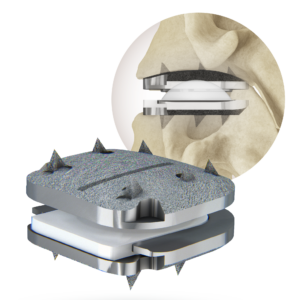Cervical disc replacement, also referred to as total disc arthroplasty, is a procedure aimed at removing a damaged cervical disc and then replacing it with an artificial disc device. Cervical discs are situated between the vertebra of the neck in the spine. They act as a cushion, absorbing shock in your neck. When these discs become damaged or displaced, it puts pressure on the spinal cord and nerves, causing pain. In some cases, it can also cause muscle spasms or numbness in the arms.
Cervical discs can come damaged through trauma or degeneration. Degeneration can be caused by disease such as arthritis or can simply be a consequence of aging. The initial treatments for symptoms of displaced cervical discs are physical therapy, medication, and potentially spinal injections. The treatment process is dependent upon what your doctor assesses is the best course of action for your condition.
If your neck pain does not ease considerably within 6-12 weeks, cervical disc replacement surgery may be considered. During surgery, your surgeon removes the disc that is pinching the nerve or applying pressure on the spinal cord. Where the disc is located determines how the surgeon goes about the procedure. Your surgeon may remove the cervical disc through a small incision in the front of your neck, which is called an anterior discectomy. If they remove the disc through a small incision in the back of your neck, the procedure is called a posterior discectomy.
Your doctor may also choose to perform a microdiscectomy. This is when the damaged disc is removed through a smaller incision than the options above, with the assistance of a microscope or other magnifying device.
Once the damaged disc is removed, it is replaced with an artificial cervical disc. The artificial disc is made of metal, but it looks and moves very similarly to an actual cervical disc.
Patients are typically discharged the same day, or the morning following surgery. Patients are asked to wear a neck collar for up to a week in order to limit neck mobility. Pain from the surgery should wear off between two to three days. Recovery times vary based on the patient’s lifestyle. Individuals with office jobs or who perform light work can typically return to their jobs within a week or two after surgery. Patients with more strenuous jobs, such as construction, must exercise more caution. It may take them up to 6 weeks before being medically cleared to return to work. About four weeks post-operation, your doctor may advise you to participate in a physical therapy program to strengthen the neck and regain flexibility.
Centinel Spine prodisc C Vivo
Dr. Wieser and Dr. Murphy often utilize the Centinel Spine prodisc C Vivo device when performing cervical disc replacements. This advanced implant is designed to ensure secure fixation, optimal fit for the patient’s anatomy, and simplified one-step insertion. Its innovative mechanism of action helps restore natural spine function while effectively reducing pain by reestablishing proper disc height.
By restoring disc height, the implant relieves pressure on nerves—“opening up” constricted nerve pathways—and helps return the vertebral joints to their natural alignment. This approach contrasts with traditional spinal fusion procedures, which permanently join vertebrae using bone grafts, implants, or cages, often reducing flexibility.
The goal of the prodisc C Total Disc Replacement is to maintain motion at the treated level of the spine and reduce stress on adjacent discs. Its unique design provides immediate stability through features like a keel and/or bone spikes, while its rough, porous surface supports long-term bone growth onto the implant for lasting fixation.
Specifically, the prodisc C Vivo implant includes six lateral spikes on the upper and lower plates. These are anchored directly into the vertebral bodies during surgery, delivering the immediate stability needed for successful recovery and function.




